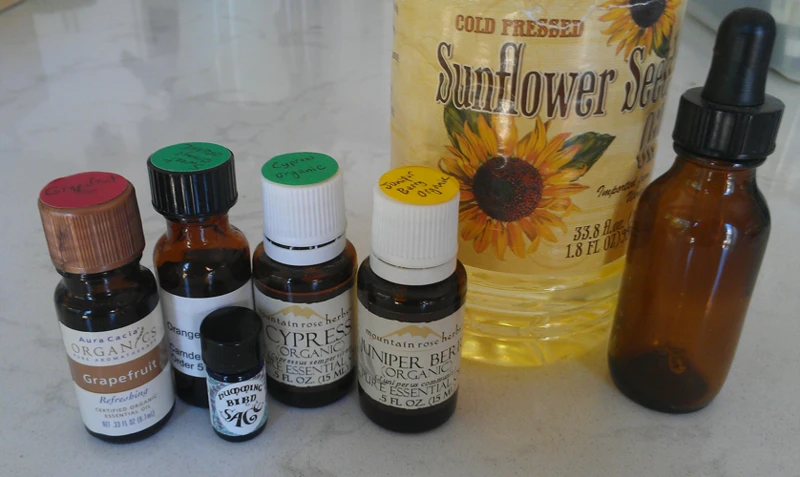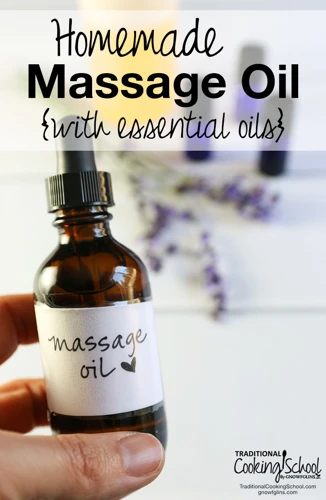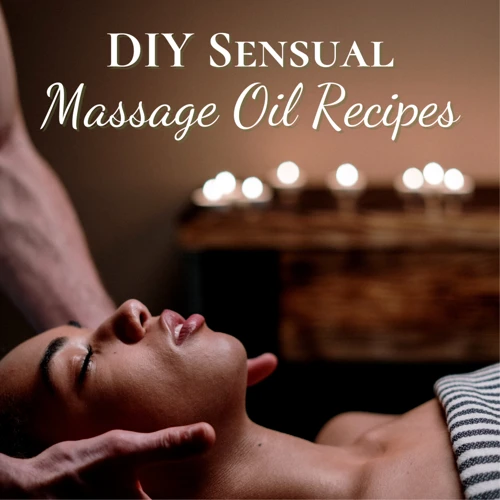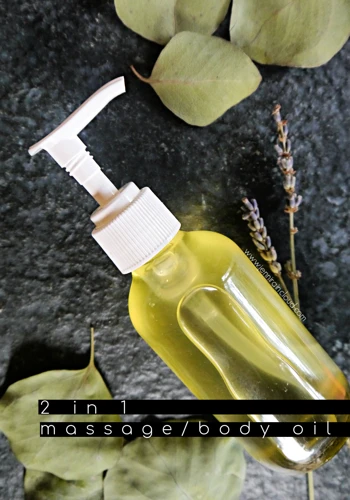Creating a massage oil with essential oils is a great way to add aromatherapy and relaxation to your massage experience. In this article, we’ll provide you with a step-by-step guide on how to make massage oil with essential oils. We’ll discuss the different types of base oils that can be used, the types of essential oils to choose from, and the correct ratios for creating a massage oil that is safe and effective. You’ll learn how to combine the ingredients to make a massage oil that has the perfect scent and therapeutic effects. Follow this guide and you’ll soon be making your own massage oil with essential oils!
Contents
What You’ll Need

Massage Oil Base
To make your own massage oil, you’ll need a base oil. Popular base oils for massage include almond, jojoba, coconut, avocado, and grapeseed oil. You can also use a combination of different oils to create a massage oil blend.
Essential Oils
Essential oils are highly concentrated aromatic compounds extracted from plants. They are a great way to add additional therapeutic benefits to your massage oil. When selecting essential oils, you’ll want to choose oils that are known to help with relaxation such as lavender, chamomile, and ylang-ylang, or that promote circulation such as rosemary, black pepper, and ginger. For best results, you’ll want to use a combination of essential oils.
When using essential oils, it is important to remember that they are highly concentrated and you should use them sparingly. Start with a few drops and add more if desired. A good rule of thumb is to not exceed a total of 5-7 drops of essential oil per tablespoon of base oil. This will help prevent skin irritation.
Choosing Essential Oils for Massage
When it comes to making massage oil with essential oils, the possibilities are truly endless. There are a variety of essential oils that can be used to create a massage oil blend to suit any taste and purpose.
Types of Essential Oils
Essential oils come from a variety of plants and can be used to create a wide range of massage oil blends. Popular essential oils for massage include lavender, lemon, peppermint, eucalyptus, sandalwood, and rosemary. Each essential oil has its own unique scent and therapeutic qualities, so it is important to choose the essential oils that will be best suited for the desired effect.
Benefits of Essential Oils in Massage
Using essential oils in massage has a variety of benefits. Essential oils can be used to help relax the body, reduce stress, and even provide relief from pain and tension. They can also help to enhance the massage experience by providing a pleasant aroma and calming atmosphere. Essential oils can be used to create a custom massage oil blend that is tailored to an individual’s needs and preferences.
Creating a massage oil blend with essential oils is a great way to relax, rejuvenate, and enjoy the therapeutic benefits of massage. With the right essential oils, you can create a massage oil blend that is perfect for a soothing and relaxing massage. Use this guide to learn how to make relaxing massage oil with essential oils and enjoy the benefits of massage!
How to Make Massage Oil with Essential Oils

How to Make Hot Oil for Body Massage
For a hot oil massage, the best ingredients are almond, apricot, or sunflower oil. Heat up the oil to a comfortable temperature and add a few drops of essential oil. This can be a combination of relaxing oils such as lavender and eucalyptus or stimulating oils such as peppermint. Mix the oil together and apply with long, gentle strokes.
How to Make Relaxing Massage Oil
To make a relaxing massage oil, you will need to mix together a carrier oil such as almond, jojoba, or coconut oil with a few drops of essential oils such as lavender, chamomile, or ylang-ylang. You can also add a few drops of rose or sandalwood oil for a relaxing scent. Gently blend the oils together and apply with long, slow strokes to soothe and relax the body.
How to Make Body Massage Oil at Home
Making your own body massage oil at home is easy. All you need is a few simple ingredients and a few essential oils. Start by combining a carrier oil such as almond, avocado, or coconut oil with a few drops of essential oil. For a relaxing massage oil, choose soothing essential oils such as lavender, chamomile, or rose. For a stimulating massage oil, choose invigorating oils such as peppermint or eucalyptus. Gently blend the oils together and apply with long, slow strokes.
How to Mix Massage Oil
It is important to mix the massage oil correctly to ensure the best results. First, combine the carrier oil with the desired essential oils. Start with a small amount of oil, such as one tablespoon of carrier oil and two or three drops of essential oil. Then, mix the oils together gently until they are fully blended. Finally, apply the massage oil with long, slow strokes.
Tips for Applying Massage Oil

When using essential oils in massage oil, it is important to follow the instructions carefully. Here are some tips for applying massage oil with essential oils:
- Always apply oil to the hands first. This helps to distribute the oil evenly and prevents any skin irritation.
- Use a light touch. When massaging with essential oil, use a light touch and avoid pressing too hard.
- Do not over massage. Massaging for too long can lead to strain and pain in the muscles.
- Be aware of allergies. If you or the person receiving the massage has known allergies, be sure to check the ingredients in the massage oil before use.
- Start with a small amount. When mixing massage oil with essential oils, it’s best to start with a small amount and then gradually increase if desired.
When mixing massage oil with essential oils, always start with a small amount and gradually increase the amount if desired. Follow the instructions on the essential oil label carefully to ensure you are mixing the right amount of essential oil into the massage oil.
Safety Considerations for Making Massage Oil

When making massage oil, safety should always be the highest priority. Essential oils are highly concentrated and can cause skin irritation, sensitivity, and an allergic reaction if not used correctly. Here are some key tips to consider when making massage oil:
- Always Use a Carrier Oil: Essential oils are potent and must be diluted before use. Adding a carrier oil like coconut, jojoba, or grapeseed oil to your essential oil blend helps reduce the risk of skin irritation and sensitization.
- Know Your Skin Type: Some essential oils are not safe for certain skin types. For example, citrus essential oils can increase photosensitivity and should not be used on sensitive or sun-exposed skin. Do your research and choose essential oils that are safe for your skin type.
- Test on a Small Area: Before using your massage oil, test it on a small area of skin to make sure you don’t have an allergic reaction. If you experience any discomfort or irritation, stop using the oil immediately and consult a doctor if necessary.
- Keep Away from Eyes: Essential oils can cause significant irritation to the eyes. Keep your massage oil away from the eyes and if accidental contact occurs, flush with cool water immediately.
By following these safety considerations, you can ensure that your homemade massage oil is both effective and safe to use.
Storage and Shelf Life of Massage Oil
Storage:
- Store massage oil in a cool and dark place away from direct sunlight or intense heat.
- Keep the oil in an airtight container to prevent it from getting contaminated.
- Always close the lid of the container tightly after use.
Shelf Life:
- The shelf life of massage oil depends on the type of oil used and the addition of various essential oils.
- The shelf life of massage oil can range from 6 months to 2 years, depending on the ingredients.
- The best way to determine the shelf life of the massage oil is to check the expiration date of the individual ingredients.
Frequently Asked Questions
What type of Carrier Oil Should I Use for Massage Oil?
When making your own massage oil, you’ll need to choose a suitable carrier oil as the base. The best carrier oils for massage are lightweight and non-greasy, such as apricot kernel, sunflower, almond, grapeseed, or jojoba oil. These are all easily absorbed into the skin, and will not leave a greasy residue. Avoid using heavy oils such as coconut or avocado oil, as these will be difficult to remove after the massage.
How Many Drops of Essential Oils Should I Use?
It is important to use the right amount of essential oil when making massage oil. Too much essential oil can be overwhelming and irritating to the skin. Too little will not provide the desired effect. The amount of essential oil used will depend on the type of oil and the desired strength. Generally, the following amounts should be used for massage oil:
- For a light scent: 10-20 drops
- For a medium scent: 21-30 drops
- For a strong scent: 31-40 drops
It is best to start with the lower amounts and add more drops as desired. It is also important to take into account the size of the bottle being used. The fewer drops used, the more diluted the oil will be.
Can I use the same massage oil on different people?
No. It is not safe to use the same massage oil on different people, even if they are family members. This is because massage oil can become contaminated with bacteria and other germs when it comes in contact with skin. It is important to use a new bottle of massage oil each time you massage someone, and dispose of the remaining oil after use.
- Always use a new bottle of massage oil for each session.
- Do not reuse massage oil from one person to another, even if they are family members.
- Dispose of the remaining oil after use.
What Precautions Should I Take When Making Massage Oil?
When making massage oil, it is important to be aware of the safety guidelines for essential oils. Always use an organic carrier oil, such as coconut, jojoba, or sweet almond oil. These oils are natural, and help to dilute the essential oils. Additionally, never apply undiluted essential oil directly to skin. Always use the recommended dilution ratio for massage oil, which is 2-4 drops of essential oil to 1 ounce of carrier oil. Additionally, be aware of any allergies that your client may have before using any essential oils. Lastly, never leave the oils in direct sunlight, as this can cause them to degrade.
How can I ensure that the massage oil is safe to use?
When using essential oils in massage oils, it is important to ensure that the combination is safe to use. Before using, check the safety guidelines for each essential oil to make sure it is safe to use and is not toxic or irritating. Additionally, it is important to ensure that the essential oil is not sensitive to light or air. If an essential oil is sensitive to light or air, it should be stored in a dark bottle and used within a few days. Finally, always do a patch test on the skin before using massage oil with essential oils on a large area.
Conclusion
Making massage oil with essential oils is a simple and cost-effective way to enjoy the benefits of aromatherapy. With the right ingredients and a few simple steps, you can create a custom blend that suits your needs. Keep in mind that essential oils should be used sparingly and with caution, and always consult your doctor before using them. With a bit of practice and creativity, you can create a massage oil that helps you relax and unwind.

